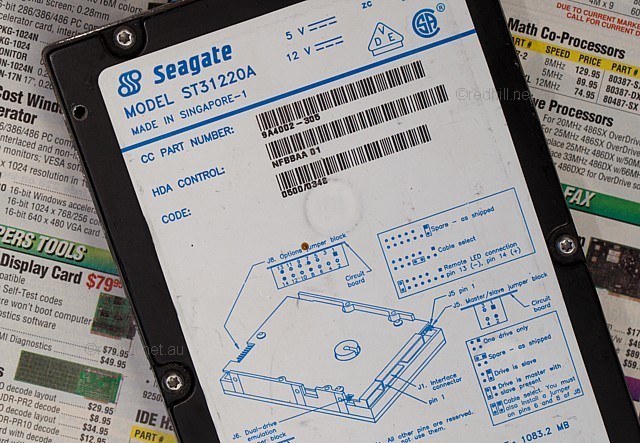
Photo: Red Hill.
Seagate Medalist 1080 family
These two drives were the first Seagate products to push past the longstanding 528MB IDE capacity barrier, arguably the first of any make. This was a major advance. They were rather expensive and quite fast — notice the cache; 256k was huge by the standards of the time. The two drives were apparently identical in all respects apart from head count: the Medalist 720 had four heads for 720MB, the Medalist 1080 six heads for a massive 1.08GB.
The smaller drive was available two or three months before the full-size version. Not to put too fine a point on things, it was a fair-dinkum dud. The return rate was very high. We sold quite a few and they nearly all came back.
Curiously enough, the Medalist 1080 turned out to be much better. We had already started selling the big drive when the 720s started failing and half-expected the near-identical Medalist 1080 to prove equally unreliable, but it didn't; we had a moderate number come back but no worse than many another model. It seems extraordinary that two such similar drives should perform so differently, but we sold too many for it to be just chance. Perhaps there was a manufacturing problem early on which had been rectified by the time we started getting shipments of the 1080. If so, then later production Medalist 720s would have been OK. We didn't try them: at about this same time Western Digital and Seagate both introduced new 850MB models which were superior in all respects. More on those shortly.
By the way, these were the last Seagate drives to use a model number indicating the unformatted capacity — all the more recent Seagates have used the more logical formatted capacity. The "ST3" indicates Seagate 3.5 inch third height, the "A" ATA (also called "IDE"), the number between is the capacity. Western Digital used a very similar scheme for a while: an AC31600, for example, was an ATA Caviar ("AC") with three discs (five or six heads), storing 1.6GB.
Like all very early large drives, the Medalist 1080 had to find a way to overcome the longstanding 528MB addressing limit. Boot sector device drivers were fragile and dangerous; mainboard LBA BIOS support was more a promise than a reality. Seagate's solution was unique: the Medalist 1080 family drives could be hardware split — by setting a jumper on the logic board, you could make one emulate two 500MB drives in master/slave mode. This was very useful for motherboards which didn't support LBA addressing, and was indeed the only way to fit a large drive to a non-LBA main board without resorting to boot sector device drivers like Ontrack Disk Mangler ... er ... I think I meant to say Disk Manager.
Illustration: Seagate Medalist 1080. Although we sold a fair number, the Medalist 720 seems to have disappeared without trace. I don't even have a dead one to take a picture of.
| Performance | 0.77 | ||
| Data rate | 47.2 Mbit/sec | Spin rate | 4500 RPM |
| Seek time | 12ms | Buffer | 256k |
| Platter capacity | 360MB | Encoding | RLL |
| Form | 3½" 1/3 height | Interface | IDE mode 4 |
| ST3780A | 720.2MB | 4 thin film heads | ** |
| Reliability | BA | ||
| ST31220A | 1.08GB | 6 thin film heads | *** |
| Reliability | AA2 |